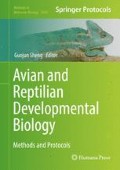Abstract
One of the advantages of the avian embryo as an experimental model is its in ovo development and hence accessibility for genetic manipulation. Electroporation has been used extensively in the past to study gene function in chicken and quail embryos . Readily accessible tissues such as the neural tube, somites, and limb bud, in particular, have been targeted. However, more inaccessible tissues, such as the embryonic urogenital system , have proven more challenging to study. Here, we describe the use of in ovo electroporation of TOL2 vectors or RCASBP avian viral vectors for the rapid functional analysis of genes involved in avian sex determination and urogenital development . In the context of the developing urogenital system , these vectors have inherent advantages and disadvantages, which will be considered here. Either vector can both be used for mis-expressing a gene and for targeting endogenous gene knockdown via expression of short hairpin RNAs (shRNAs). Both of these vectors integrate into the genome and are hence spread throughout developing tissues. Going forward, electroporation could be combined with CRISPR/Cas9 technology for targeted genome editing in the avian urogenital system .
Access this chapter
Tax calculation will be finalised at checkout
Purchases are for personal use only
References
Burt DW (2004) The chicken genome and the developmental biologist. Mech Dev 121:1129–1135
Nakamura H, Katahira T, Sato T et al (2004) Gain- and loss-of-function in chick embryos by electroporation. Mech Dev 121:1137–1143
Rios AC, Marcelle C, Serralbo O (2012) Gene loss-of-function and live imaging in chick embryos. Methods Mol Biol 839:105–117
Itasaki N, Bel-Vialar S, Krumlauf R (1999) “shocking” developments in chick embryology: electroporation and in ovo gene expression. Nat Cell Biol 1:E203–E207
Chernet BT, Levin M (2012) A versatile protocol for mRNA electroporation of Xenopus laevis embryos. Cold Spring Harb Protoc 2012:447–452
Teh C, Parinov S, Korzh V (2005) New ways to admire zebrafish: progress in functional genomics research methodology. BioTechniques 38:897–906
Logan M, Tabin C (1998) Targeted gene misexpression in chick limb buds using avian replication-competent retroviruses. Methods 14:407–420
Andermatt I, Wilson N, Stoeckli ET (2014) In ovo electroporation of miRNA-based-plasmids to investigate gene function in the developing neural tube. Methods Mol Biol 1101:353–368
Farley EK (2013) Gene transfer in developing chick embryos: in ovo electroporation. Methods Mol Biol 1018:141–150
Blank MC, Chizhikov V, Millen KJ (2007) In ovo electroporations of HH stage 10 chicken embryos. J Vis Exp 9:408
Sato Y, Kasai T, Nakagawa S et al (2007) Stable integration and conditional expression of electroporated transgenes in chicken embryos. Dev Biol 305:616–624
Smith C, Roeszler K, Ohnesorg T et al (2009) The avian Z-linked gene DMRT1 is required for male sex determination in the chicken. Nature 461:267–271
Lambeth LS, Raymond CS, Roeszler KN et al (2014) Over-expression of DMRT1 induces the male pathway in embryonic chicken gonads. Dev Biol 389:160–172
Zhang SO, Mathur S, Hattem G et al (2010) Sex-dimorphic gene expression and ineffective dosage compensation of Z-linked genes in gastrulating chicken embryos. BMC Genomics 11:13
Major AT, Smith CA (2016) Sex reversal in birds, sexual development. Sex Dev 10(5–6):288–300
Ayers KL, Lambeth LS, Davidson NM et al (2015) Identification of candidate gonadal sex differentiation genes in the chicken embryo using RNA-seq. BMC Genomics 16:704
Ayers KL, Davidson NM, Demiyah D et al (2013) RNA sequencing reveals sexually dimorphic gene expression before gonadal differentiation in chicken and allows comprehensive annotation of the W-chromosome. Genome Biol 14:R26
Zhao D, McBride D, Nandi S et al (2010) Somatic sex identity is cell autonomous in the chicken. Nature 464:237–242
Hamburger V, Hamilton H (1951) A series of normal stages in the development of the chick embryo. J Morphol 88(1):49–92
Guioli S, Nandi S, Zhao D et al (2014) Gonadal asymmetry and sex determination in birds. Sex Dev 8:227–242
Guioli S, Sekido R, Lovell-Badge R (2007) The origin of the Mullerian duct in chick and mouse. Dev Biol 302:389–398
Takahashi Y, Watanabe T, Nakagawa S et al (2008) Transposon-mediated stable integration and tetracycline-inducible expression of electroporated transgenes in chicken embryos. Methods Cell Biol 87:271–280
Yokota Y, Saito D, Tadokoro R et al (2011) Genomically integrated transgenes are stably and conditionally expressed in neural crest cell-specific lineages. Dev Biol 353:382–395
Ayers KL, Cutting AD, Roeszler KN et al (2015) DMRT1 is required for Müllerian duct formation in the chicken embryo. Dev Biol 400:224–236
Sekido R, Lovell-Badge R (2007) Mechanisms of gonadal morphogenesis are not conserved between chick and mouse. Dev Biol 302:132–142
Hughes SH (2004) The RCAS system. Folia Biol (Praha) 50(3–4):107–119
Smith CA, Roeszler KN, Sinclair AH (2009) Robust and ubiquitous GFP expression in a single generation of chicken embryos using the avian retroviral vector, RCASBP. Differentiation 77:473–482
Ahronian LG, Lewis BC (2014) Generation of high-titer RCAS virus from DF1 chicken fibroblasts. Cold Spring Harb Protoc 2014:1161–1166
Smith CA, Roeszler KN, Sinclair AH (2009) Genetic evidence against a role for W-linked histidine triad nucleotide binding protein (HINTW) in avian sex determination. Int J Dev Biol 53:59–67
Author information
Authors and Affiliations
Corresponding author
Editor information
Editors and Affiliations
Rights and permissions
Copyright information
© 2017 Springer Science+Business Media LLC
About this protocol
Cite this protocol
Hirst, C.E., Serralbo, O., Ayers, K.L., Roeszler, K.N., Smith, C.A. (2017). Genetic Manipulation of the Avian Urogenital System Using In Ovo Electroporation. In: Sheng, G. (eds) Avian and Reptilian Developmental Biology. Methods in Molecular Biology, vol 1650. Humana Press, New York, NY. https://doi.org/10.1007/978-1-4939-7216-6_11
Download citation
DOI: https://doi.org/10.1007/978-1-4939-7216-6_11
Published:
Publisher Name: Humana Press, New York, NY
Print ISBN: 978-1-4939-7215-9
Online ISBN: 978-1-4939-7216-6
eBook Packages: Springer Protocols

